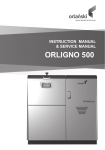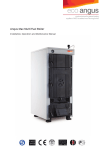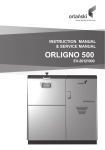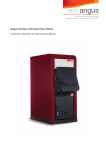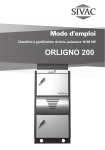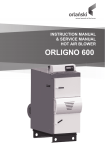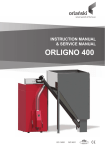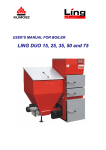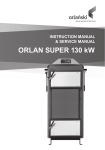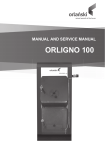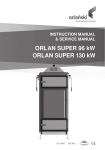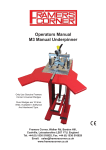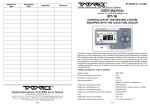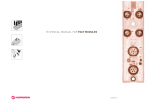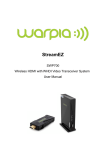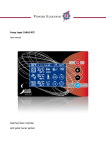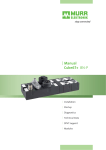Download Here
Transcript
Angus Orligno 500 Multi Fuel Boiler Instruction and Service Manual Index Instruction Manual 1. Boiler application . . . . . . . . . . . . . . . . . . . . . . . . . . . . . . . . . . . . . . . . . . . . . . . . . . . . . . . . . . . . . . . . . . . . . . . . . . . . 1 2. Description of the controller . . . . . . . . . . . . . . . . . . . . . . . . . . . . . . . . . . . . . . . . . . . . . . . . . . . . . . . . . . . . . . . . . . . . . 1 2.1 Igniting . . . . . . . . . . . . . . . . . . . . . . . . . . . . . . . . . . . . . . . . . . . . . . . . . . . . . . . . . . . . . . . . . . . . . . . . . . . . . 3 3. Controller’s menu descriptions . . . . . . . . . . . . . . . . . . . . . . . . . . . . . . . . . . . . . . . . . . . . . . . . . . . . . . . . . . . . . . . . . . . 4 3.1 Menu handling .......................................................................4 3.2 Alarm status and safety devices . . . . . . . . . . . . . . . . . . . . . . . . . . . . . . . . . . . . . . . . . . . . . . . . . . . . . . . . . . . . 8 4. Feed system . . . . . . . . . . . . . . . . . . . . . . . . . . . . . . . . . . . . . . . . . . . . . . . . . . . . . . . . . . . . . . . . . . . . . . . . . . . . . . . . 9 4.1 Feed system – alarm status . . . . . . . . . . . . . . . . . . . . . . . . . . . . . . . . . . . . . . . . . . . . . . . . . . . . . . . . . . . . . . . 9 4.2 Feed system protection . . . . . . . . . . . . . . . . . . . . . . . . . . . . . . . . . . . . . . . . . . . . . . . . . . . . . . . . . . . . . . . . . . 9 5. Maintenance . . . . . . . . . . . . . . . . . . . . . . . . . . . . . . . . . . . . . . . . . . . . . . . . . . . . . . . . . . . . . . . . . . . . . . . . . . . . . . 10 Service Manual 1. Installation . . . . . . . . . . . . . . . . . . . . . . . . . . . . . . . . . . . . . . . . . . . . . . . . . . . . . . . . . . . . . . . . . . . . . . . . . . . . . . . . 11 2. Recommended controller settings . . . . . . . . . . . . . . . . . . . . . . . . . . . . . . . . . . . . . . . . . . . . . . . . . . . . . . . . . . . . . . . . 11 3. Block diagram . . . . . . . . . . . . . . . . . . . . . . . . . . . . . . . . . . . . . . . . . . . . . . . . . . . . . . . . . . . . . . . . . . . . . . . . . . . . . . 12 4. Technical data . . . . . . . . . . . . . . . . . . . . . . . . . . . . . . . . . . . . . . . . . . . . . . . . . . . . . . . . . . . . . . . . . . . . . . . . . . . . . . 13 4.1 Dimensions . . . . . . . . . . . . . . . . . . . . . . . . . . . . . . . . . . . . . . . . . . . . . . . . . . . . . . . . . . . . . . . . . . . . . . . . . 13 4.2 Boiler technical data . . . . . . . . . . . . . . . . . . . . . . . . . . . . . . . . . . . . . . . . . . . . . . . . . . . . . . . . . . . . . . . . . . . 14 4.3 Controller’s technical data . . . . . . . . . . . . . . . . . . . . . . . . . . . . . . . . . . . . . . . . . . . . . . . . . . . . . . . . . . . . . . . 15 4.4 Electrical data of gear-motors . . . . . . . . . . . . . . . . . . . . . . . . . . . . . . . . . . . . . . . . . . . . . . . . . . . . . . . . . . . . 15 4.5 Mechanical data of gear-motors . . . . . . . . . . . . . . . . . . . . . . . . . . . . . . . . . . . . . . . . . . . . . . . . . . . . . . . . . . 16 4.6 Heater’s technical data . . . . . . . . . . . . . . . . . . . . . . . . . . . . . . . . . . . . . . . . . . . . . . . . . . . . . . . . . . . . . . . . . 16 5. Boiler’s electrical diagram . . . . . . . . . . . . . . . . . . . . . . . . . . . . . . . . . . . . . . . . . . . . . . . . . . . . . . . . . . . . . . . . . . . . . 17 6. Boiler connection . . . . . . . . . . . . . . . . . . . . . . . . . . . . . . . . . . . . . . . . . . . . . . . . . . . . . . . . . . . . . . . . . . . . . . . . . . . . 19 6.1 Connection scheme . . . . . . . . . . . . . . . . . . . . . . . . . . . . . . . . . . . . . . . . . . . . . . . . . . . . . . . . . . . . . . . . . . . 19 6.2. Hydraulic connections . . . . . . . . . . . . . . . . . . . . . . . . . . . . . . . . . . . . . . . . . . . . . . . . . . . . . . . . . . . . . . . . . 20 6.3 Cooling coil . . . . . . . . . . . . . . . . . . . . . . . . . . . . . . . . . . . . . . . . . . . . . . . . . . . . . . . . . . . . . . . . . . . . . . . . . 20 7. Boiler tightness . . . . . . . . . . . . . . . . . . . . . . . . . . . . . . . . . . . . . . . . . . . . . . . . . . . . . . . . . . . . . . . . . . . . . . . . . . . . . 21 8. Ventilation . . . . . . . . . . . . . . . . . . . . . . . . . . . . . . . . . . . . . . . . . . . . . . . . . . . . . . . . . . . . . . . . . . . . . . . . . . . . . . . . . 21 8.1 Air supply ventilation . . . . . . . . . . . . . . . . . . . . . . . . . . . . . . . . . . . . . . . . . . . . . . . . . . . . . . . . . . . . . . . . . . . 21 8.2 Exhaust ventilation . . . . . . . . . . . . . . . . . . . . . . . . . . . . . . . . . . . . . . . . . . . . . . . . . . . . . . . . . . . . . . . . . . . . 21 9. Chimney connection . . . . . . . . . . . . . . . . . . . . . . . . . . . . . . . . . . . . . . . . . . . . . . . . . . . . . . . . . . . . . . . . . . . . . . . . . 21 10. Troubleshooting . . . . . . . . . . . . . . . . . . . . . . . . . . . . . . . . . . . . . . . . . . . . . . . . . . . . . . . . . . . . . . . . . . . . . . . . . . . . 22 11. Disposal . . . . . . . . . . . . . . . . . . . . . . . . . . . . . . . . . . . . . . . . . . . . . . . . . . . . . . . . . . . . . . . . . . . . . . . . . . . . . . . . . 22 1. Boiler application The Orligno 500 low temperature pellet boiler is produced by Eko-Vimar Orlanski Ltd.and has been adapted for central heating and domestic hot water installations. The main fuel used in the Orligno 500 are pellets with a 6-8mm diameter and length of 10-50mm. The capacious pellet hopper ensures longer boiler operation and reduced re-filling of the hopper. The boiler is adapted for installation in an open or pressurised system with pressure vessel allowing to work with working pressure. 2. Description of the controller The boiler’s controller is a modern microprocessor system which controls not only the boiler but also central heating system and domestic hot water. The device controls quantity of feed fuel through periodic operation of feeder’s engine and the amount of supplied air for the burning process.Thanks to semiconductor transmitters the power of the blower is fluently adjusted thus increasing reliability of control system of feeder’s engine. Automatic burning up. Controller enables automatic burning up of the fuel on the burner. Measurement of fumes temperature. The controller enables reading fumes temperature, which is necessary for boiler operation with automatic igniting. Measurement of fumes temperature is important for the control and ajustment of the boiler. Thanks to the advanced algorithm it is possible to adjust many parameters; the system can be easily adapted to your heating needs. The controller is equipped with an output test function which checks the correct electrical connections and executive devices (pump, blower, feeder, mixing valve’s actuator) before the boiler is put into action. The alphanumeric display makes it easier to communicate between the user and controller, easy handling. New intuitive controller’s menu with 6 languages of choice: Polish, English, German, French, Lithuanian and Russian. INSTRUCTION AND SERVICE MANUAL 1 Pic 1. Controller’s menu INSTRUCTION AND SERVICE MANUAL 2 2.1 Igniting 1. Pour the pellets into the hopper and tightly close the lid. 2. Connect the main power plug into the 230V/50 socket. ATTENTION! The socket should be protected with a minimum 10A fuse and 20 mA RCD (residual current device). 3. Start the controller. To start the controller it is necessary to press the “ON/OFF/ESC” button for 3 seconds. The same process applies in order to switch off the controller. Present status is shown on the display: OFF – (active control of alarm parameters, manual mode of blower and feeder) ON ATTENTION! When “OFF” is shown on the display the device is in standby mode and is still live. In case of alarm the controller will activate all pumps or feeders. ATTENTION! It is forbidden ignite the boiler using any flammable substances. If the boiler is in idle time or maintenance is required, it is essential to disconnect the boiler from the power supply. The display shows current status of individual devices. The picture below shows main menu view. fig. 2. Main display. Pic 2. Main display The last line on the display shows abbreviations of the active devices. Table 1. Abbreviation table for device names INSTRUCTION AND SERVICE MANUAL 3 After pouring in the pellets it is recommended to manually start the feeder in order to transport fuel to the burner. Go to menu MANUAL MODE, which is displayed below: Pic 3. Manual mode To turn ON/OFF the feeder press To turn ON/OFF the blower press Feeders should work until filling the burner with fuel. Next switch the controller to ON mode and fuel will be automatically ignite. 3. Controller’s menu descriptions 3.1 Menu handling Controller has two types of menus: SIMPLE MENU and ADVANCED MENU. ATTENTION! To change the type of menu: SIMPLE or ADVANCED press / at the same time. After 10 minutes of inactivity the menu will automatically change to the SIMPLE menu. ATTENTION! The instruction manual contains all control parameters available for both SIMPLE and ADVANCED menus. Parameters for the ADVANCED menu are written in italics. To go to the main menu press “ENTER” button. – Main menu, written with capital letters, buttons and are to navigate within the main menu, to go to the sub menu press “ENTER”. To exit from sub menu press “ESC”. Main menu is shown in Pic. 4 below. – The sub menu is for displaying and changing operation parameters. In order to change the parameter press “ENTER”. Changing parameter will be displayed periodically. To change the parameter to a different one press or . To exit from changed parameter press “ESC”. To accept the changes press “ENTER” . 2. Regulator description. Pic. 4 Main menu INSTRUCTION AND SERVICE MANUAL 4 Boiler menu The boiler can operate in one of two operation modes: manual and auto. Pic. 5 Boiler menu ATTENTION! Operation modes decide only about setting method of the boiler temperature. Parameters Auto mode – recommended mode. The boiler’s temperature is automatically set depending on heat demand. Manual mode – Boiler’s temperature is set by the user. Service – parameter informing about boiler maintenance. Hysteresis (only in ADVANCED menu) – parameter showing the difference between actual boiler’s temperature and set one to start the burner. Heating menu Menu for central heating settings. Heating menu is shown in picture below. Pic. 6 Heating circuit menu Parameters Progr. – maintains temperature in heating circuit (radiators, underfloor heating) during demand from room thermostat. Heating – parameter for turning OFF/ON heating. Reduction (only in ADVANCED menu) – parameter for adjusting the temperature value. ATTENTION! In case of the mixing valve with actuator not being installed in the central heating circuit, parameters “progr” and “reduction” are turned off. ATTENTION! In case of the mixing valve with actuator not being installed in the central heating circuit – during the first start of the boiler, the parameter “mixer” needs to be changed to “no” in the SERVICE menu. INSTRUCTION AND SERVICE MANUAL 5 Hot water menu The pellet boiler is perfectly matched for hot water heating both during the winter and summer seasons. The hot water menu is shown below: Pic. 7 Hot water menu Prog. H.W. (programmed hot water) The hot water tank needs to be equipped with a temperature sensor. Parameters Programmable hot water temperature (prog. h.w.) – hot water temperature kept in the tank. Hot water – parameter for turning on/off hot water function. Priority (only in ADVANCED menu) – with priority parameter “on” during hot water heating the rest of the pumps in the installation are off in order accelerate the heating of the water. Hysteresis (only in ADVANCED menu) – temperature value that is needed to decrease temperature of hot water to start heating hot water and temp. value that is needed to increase the switching off of the hot water heating. Boiler h.w. + (only in ADVANCED menu) – temperature value that need to increase to programmed temperature during hot water heating. i.e. if programmed temp of hot water = 60°C and “boiler h.w.+” = 10°C then the programmed temperature during heating hot water is 70°C. Advanced priority of hot water The controller can operate in two modes of hot water heating (only in gas and oil boilers): hot water priority (recommended) and without priority. During boiler operation in priority mode with the hot water heating, it operates only the hot water pump reaching the set temperature much quicker. In order to avoid temperature drop in the house during hot water heating and the pump operating for longer longer than 20 minutes (pre-set) and programmed temperature of hot water is not reached;the central heating pump will start working within 5 minutes. The parameters that are available in the service menu are: “stop central heating pump with hot water pump” (stop HP/HWP) and “work central heating pump with hot water pump”(work HP/HWP). Pic. 8 Pump operation during hot water heating in priority mode INSTRUCTION AND SERVICE MANUAL 6 Input menu The input menu shows temperatures of all connected sensors to the controller. The input menu view is shown below: Pic. 9 Input menu Buffer menu This is the menu for the adjustment of buffer parameters. Buffer menu view is shown below: Pic. 10 Buffer menu Parameters Programmed top – programmable temperature in the upper part of the buffer. Programmed down – programmable temperature in the lower part of the buffer. Operation description The buffer pump will be on when temperature in upper part of the buffer drops below programmed temperature. The buffer charging lasts until both programmed temperatures are reached. ATTENTION! The buffer menu is only available in ADVANCED menu. Parameters Burner power – available in two modes: auto (recommended) and manual. In auto mode the controller selects burner power according to the energy demand of the house. Programmed power – in auto mode the actual power of the burner is displayed, in manual mode the burner power can be set as a constant. ATTENTION! Buffer menu is only available in ADVANCED menu. Language menu The controller is equipped with multilingual menus: Polish, English, German, French, Lithuanian and Russian. Language selection is made in the language menu. INSTRUCTION AND SERVICE MANUAL 7 3.2 Alarm status and safety devices The alarm status is indicated with blinking backlight on the controller’s display. After pressing “ENTER”, the type of alarm is displayed. The types of alarms are: ■ Boiler overheating Alarm is indicated after exceeding 97°C (pre-set) on the boiler. Controller will activate all connected pumps until temperature will decrease. ATTENTION! With the temperature 2oC lower than the alarm temperature, pumps are activated in a initial alarm mode. If the temperature does not exceed the alarm temperature it will not be remembered in the controller’s memory. ■ No fuel/fire The alarm is activated if there is a lack of fuel or fire in the burner. ■ Feeder overheating The alarm is activated when the feeder’s permissible temperature is exceeded. ATTENTION! After noticing the alarm status, it is recommended to determine the cause and rectify it. ■ Thermal boiler protection is independent from the boiler’s controller In case of the boilers temperature exceeding 94°C, the thermal boiler protection will turn off the blower. ATTENTION! After the alarm goes off it is recommended to determine the cause of the alarm, rectify it and manually unblock thermostat. INSTRUCTION AND SERVICE MANUAL 8 4. Feed system Pic. 11 Feed system section 4.1 Feed system – alarm status In case of the temperature exceeding 60°C in the feed system, the alarm is activated with a blinking display “feeder overheating”. ATTENTION! After the alarm goes off it is recommended to determine the cause of the alarm, rectify it and manually unblock thermostat. 4.2 Feed system protection The feed system is designed in such a way that the flame from the burner is not able to come into contact with the pellet hopper. Safe feeding is ensured by a system of two feeders joined together with a flexible, vertical chute. Fuel feeding is continually monitored by the boiler’s controller. The proper feeders co-operation guarantees that the vertical chute is always empty – it is a burn-back protection. INSTRUCTION AND SERVICE MANUAL 9 5. Maintenance Ash generated during pellet burning is deposited in the bottom chamber. The bottom chamber needs to be cleaned once a month with the scraper and cleaning shield. It is advisable to clean the heat exchanger at least once a month to ensure permeability of pipes. If the fumes temperature exceeds the maximum value displayed it will be necessary to clean the heat exchanger pipes and boiler. Once a week the burner needs to be checked thoroughly due to the possibility of deposits of unburned parts of pellets (especially when the pellet quality is bad) which may block the pellet feeding and cause uncontrolled burning. ATTENTION! If unproper pellet issue will repeat it is necessary to fully open blower’s screen. In order to clean the heat exchanger: 1. Open upper door. 2. Unscrew two nuts with M13 wrench (they secure heat exchanger’s plate behind which horizontal pipes are placed). 3. Remove turbulators and clean pipes with shield and turbulators with the brush. 4. Place turbulators back into the heat exchanger. ATTENTION! If unproper pellet issue will repeat it is necessary to fully open blower’s screen. Steps for correct door regulation: WARNING! Regulation should be made on both upper and bottom hinges at the same time. All moving door parts should be greased periodically (for example with a grease or an oil) as well as the hinges. INSTRUCTION AND SERVICE MANUAL 10 1. Installation Boilers should be installed according to binding rules and norms. The requirements of norm PN 87/B 02411 according to the building of a solid fuel boiler room, and the norm PN 91/B 02413 according open system boilers’ production should be taken into account. These norms and rules should be followed. However, caution is required as national rules in countries to which the product is sold may replace the above-mentioned norms. In case of boiler assembly outside Poland, rules and norms should be followed according to solid fuel boiler assembly in countries in which the boiler is sold. The Orligno 500 boiler is adjusted for installation in pressurized systems. Eko-Vimar Orlanski Ltd. recommends the use of stainless steel flue liners that protect the chimney from the damaging effects of wood tar. The Eko-Vimar Orlanski Company does not take responsibility for anyone not complying to the above recommendations and any damage resulting from it. During boiler transport, the boiler flue may be disassembled by unscrewing nuts (8xM8) and detaching the flue from the flange. At the bottom chamber, wrapped in foil are ceramic moulders which need to be placed on the burner as shown below. Pic. 12 Ceramic layout of the burner 2. Recommended controller settings Lp. Description Programmed parameter 1. Boiler operation Auto mode 2. Heating temperature 60°C 3. Maximum underfloor heating temperature 45°C 4. Thermostat -15°C 5. Hot water temperature 45°C 6. Priority yes 7. Hysteresis 2°C 8. Boiler h.w. +10°C 9. Buffer upper temperature 60°C 10. Buffer down temperature 80°C INSTRUCTION AND SERVICE MANUAL 11 3. Block diagram Pic. 13 Controller’s block diagram INSTRUCTION AND SERVICE MANUAL 12 4. Technical data 4.1 Dimensions Pic. 14 INSTRUCTION AND SERVICE MANUAL 13 4.2 Boiler technical data Lp. Description j.m. Value 1. Boiler output kW 25 2. Power range kW from 7 to 25 3. Boiler class acc. norm EN 303-5 3 (highest) 4. Efficiency % ~92 5. Fuel: pellets length diameter moisture content mm mm % 10-50 6-8 8-12 Fuel consumption: nominal minimal kg/h kg/h 5.5 1.5 6. 7. Approximate heating space m2 to 250 8. Maximum working pressure bar 2.5 9. Maximum water temperature °C 85 10. Minimum return water temperature °C 60 11. Flue diameter mm 160 12. Required chimney draught mbar from 0.1 to 0.2 13. Fumes temperature: nominal minimal °C 160 130 kg/s kg/s 0.02 0.01 kg 320 14. Fumes flow: nominal minimal 15. Weight 16. Water capacity litres 60 17. Hopper capacity litres 255 18. Loading opening dimensions width/length mm 260/432 19. Cooling coil water temperature °C 10 20. Minimum water pressure in cooling coil bar 2 21. Voltage/Frequency AC V/Hz 230/50 22. Auxilliary power W 250 23. Recommended capacity of accumulation tank litres 1,000-2,000 INSTRUCTION AND SERVICE MANUAL 14 4.3 Controller’s technical data Lp. Description 1. Power AC 2. Power consumption (controller) j.m. Value ~V/Hz 230/50±10% VA <5 OUTPUT LOAD 3. Central heating pump W 100 4. Hot water pump W 100 5. Buffer pump W 100 6. Heater W 400 7. Blower W 150 8. Gear – motor 1 W 200 9. Gear – motor 2 W 150 10. Mixing valve actuator W 50 11. Boiler temperature range °C 60-85 12. Hot water temperature range °C 35-70 13. Measurement accuracy °C ±2 14. Ambient temperature °C 0-60 15. Moisture content % 5-95 without condensation 16. Alarm temperature – range °C 80-95 4.4 Electrical data of gear-motors L.p. Description j.m. Value – – 1. Type – motor with gear 2. Voltage AC ~V/Hz 230/50 3. Pole number P 2 Power A 0.65 ± 15% Input power W 72 ± 15% rot/min 5.4 ± 10% V 161 Max. Limit load Nm 33 Min. Acceptable load Nm 25 Min. Start load Nm 20 Min. Motor characteristic without load 4. Rotation speed Start voltage Load characteristic – after 1 min since start of motor 5. 6. Maximum current A 1.2 Max. 7. Dielectric resistance Motor resistant voltage: 1500V RMS through 1 min (1800V RMS through 1 sec) measured between coil and motor’s core (test current 3 mA) – – 8. Insulation coefficient 100 MΩ minimum at 500V of voltage measured between coil and cover – – 9. Thermal protection: Motor protected up 120°C – – 10. Insulation class Class “E” INSTRUCTION AND SERVICE MANUAL 15 4.5 Mechanical data of gear-motors L.p. Description j.m. Value - - 1. Lubrication – Mineral oil and grease 2. Noisness (without load) dB 25 MAX 3. Weight kg 2.2 4. Shaft position – horizontal – – 5. Shift – 1: 532 j.m. Value - - V-AC 120 -15%/+10% (102-132) A/V-AC 3.3-4.2/120 4.6 Heater’s technical data L.p. Description 1. Type – GLO 120-400 2. Input voltage range (co-operate with adapter 230/120 VAC) 3. Current 4. Heater power W 400 6. Heater temperature °C 1,200 7. Time for warm up to 1,200°C sek. >12 9. Heater material: ceramic – recrystallised Si3N4 - - 10. Safety norm CSA - - INSTRUCTION AND SERVICE MANUAL 16 5. Boiler’s electrical diagram Pic. 15 Electrical diagram INSTRUCTION AND SERVICE MANUAL 17 Electrical connection of equipment to the boiler’s controller Low-voltage contact Tco – temperature sensor connection for central heating Tcwu – sensor connection for hot water pump Tbg – sensor connection in upper part of the buffer Tbd – sensor connection in down part of the buffer Rpok – room thermostat connection High-voltage contact M.co – mixing valve’s actuator connection P.cwu – hot water pump connection P.bu – buffer pump connection – pump responsible for maintaining right return temperature to the boiler P.co – central heating pump connection Room thermostat Controller enables co-operation with any room thermostat with closing contact. Room thermostat should be installed in a representative room in the house with respect to temperature at 1.5-2.0m height. Room thermostats should not be installed close to any heat source (e.g. TV, radiator), direct sun radiation or places exposed to draughts. Pic.16 Room thermostat connection INSTRUCTION AND SERVICE MANUAL 18 6. Boiler connection 6.1 Connection scheme Pic.17. Boiler connection scheme Connection scheme 1. Orligno 500 pellet boiler 2. Buffer-boiler pump 3. Supply manifold 4. Three-way mixing valve 230V 5. Circulation pump 6. Differential valve 7. Return manifold 8. Radiator 9. Hot water pump 10. Hot water tank 11. Hot water outlet 12. Cold water inlet 13. Pressure tank 14. Safety group 15. Buffer tank 16. Set of solar collectors 17. Central heating sensor 18. Upper part sensor 19. Down part sensor 20. Solar collector pump 21. Hot water measurement INSTRUCTION AND SERVICE MANUAL 19 6.2 Hydraulic connections Pic.18 Connections to the boiler 6.3 Cooling coil In connection to the thermostatic valve BVTS, this protects the boiler from overheating. Cooling coil needs to be connected to cold water installation through thermostatic valve BVTS. Cooling coil outlet should be connected to drains. Pic.19 BVTS connection scheme INSTRUCTION AND SERVICE MANUAL 20 7. Boiler tightness It is very important to ensure boiler tightness, especially door tightness. Leaks may cause fumes to escape from the boiler room and lead to uncontrolled burning. To ensure correct door tightness, the rope needs to be checked periodically and if it is damaged – replaced. Insulation rope in bottom door needs to greased at least once a month with oil or graphite grease. 8. Ventilation According to European safety regulations each boiler room should have supply-exhaust ventilation that ensures correct boiler operation and user’s safety. Lack of ventilation or its obstruction is the main reason of incorrect boiler operation (i.e. boiler cannot reach set temperature). Exhaust ventilation removes used air and harmful gases from the boiler room. A boiler room with natural ventilation cannot have mechanical ventilation installed. 8.1 Air supply ventilation 1. The ventilating duct section should have at least 50% area of the chimney’s section and not less than 20x20cm. The duct should be placed at least 1m above the floor. 2. The ventilating duct should have a device installed for air flow control; the device shouldn’t limit duct section above 1⁄5. Ventilating duct should be made of non-flammable material. 8.2 Exhaust ventilation 1. The xhaust duct should be made of bricks with section of at least 25% of chimney section and not less 14x14cm. Inlet hole cannot have any devices that reduce its section. Outlet hole should be placed close to the ceiling led out 1.5 m above the roof. Ventilating duct should be made of non-flammable material. 2. The mimumum height of the boiler room should be 2.2m. 9. Chimney connection Chimney ducts should be installed according to binding rules and norms in countries to which boilers are sold. The part of the chimney system connecting the boiler to the chimney is called a flue. In order to lower flow resistance of exhaust gases this part should be a straight pipe with, if necessary, joints up to 45°C. Because of the temperature of exhaust gases Orligno 500’s need to be connected to a chimney system to protect against condensation. Closing door should be installed with tight closing 30cm above the floor. Chimney section should be round or close to square shape because of low flow resistance. The mimumum flue diameter should be at least 160mm. Chimney should lead above the roof. Chimney outlet location is dependent on roof slope and its combustibility. Eko-Vimar Orlań ski Ltd. recommends to install a draught regulator which stabilises chimney draught. INSTRUCTION AND SERVICE MANUAL 21 10. Troubleshooting Symptom Alarm: No fire/fuel Boiler cannot reach programmed temperature Boiler is fuming Door is fuming Controller doesn’t work Loud blower operation Reason Action Lack of fire Refill hopper acc. to point “Lightning up” Wrong lightning up Check “Lightning up” Pellets too damp Check moisture – use pellet with required parameters Clogged primary air channels Call service – after-warranty service Clogged heat exchanger’s pipes Clean pipes or call service – after-warranty service Damaged gasket on blower’s or burner’s flange Replace – after-warranty service Damaged blower Replace – after-warranty service Clogged or unproper chimney Get advice from a chimney sweeper Strong wind forces fumes into the chimney Consider installation of devices regulating chimney draught Gasket leak Regulate the door’s hinges Damaged rope Replace the rope – after-warranty service No voltage in the grid Check the protection devices in the electric installation Damaged wire Wire and connection control Damaged controller Call for service Damaged bearings Call for service – replace the blower Damaged capacitor Call for service – replace the capacitor Loosen fixing of blower Screw in fixing control Dirty rotor blades Control, cleaning 11. Disposal Currently he appliance is marked according to European Directive 2002/96/EC on waste electrical and electronic equipment. Symbol placed on the components or attached documents means that the appliance is not classified as household waste. Scrapping should take place at a special collection point in order to recycle the electrical and electronic components. INSTRUCTION AND SERVICE MANUAL 22 For more information please visit our website www.ecoangus.co.uk 01934 862642 07739 174511 07970 901273 [email protected]

























